by T. Sabaratnam, May 20, 2004
Chapter 2
Original index to series
I was upset when I saw flames leap up in the direction of Borella. I was deeply troubled when more tongues of flame rose threateningly in that vicinity. Was the information Piyadasa had given me coming true?
Telephone calls further disturbed me. Tamils were frantically telephoning our News Desk to find out whether another racial attack had been unleashed.
Former Telecommunications Minister C. Kumarasuriyar was one of the callers. “Has Jayewardene let loose his hit squad on the Tamils again?” he asked.
I passed him the information Piyadasa gave me of attempts to turn the anti-government fury on the Tamils.
“I spoke to Madam,” he said. “She seems to think that “that ra—- would do anything to entrench himself in power.”
The ‘Madam’ with whom Kumarasuriyar had spoken was Sirimavo Bandaranaike, under whom he served as minister.
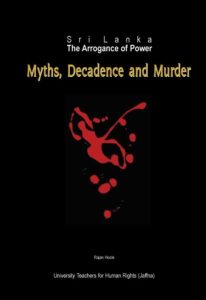 Later investigations revealed that that was what happened at the Borella junction. Rajan Hoole, in his book Sri Lanka – The Arrogance of Power, reconstructed the events at Kanatte and Borella and later at Maradana in detail. He says this in page 107:
Later investigations revealed that that was what happened at the Borella junction. Rajan Hoole, in his book Sri Lanka – The Arrogance of Power, reconstructed the events at Kanatte and Borella and later at Maradana in detail. He says this in page 107:
All our sources are agreed that the initial mood of the crowd that left Kanatte was anti-government. According to some of them, at about 10 p.m. fresh gangs were brought to Borella junction which raised the anti- Tamil cry. They were identified as government gangs. According to these reports when the crowd from Kanette encountered the gangs freshly brought in, there was a hoot. Thereafter the anti-government cry subsided and the anti- Tamil cry became dominant. This according to some sources was the beginning of arson and the murder of Tamils who fell into the mob.
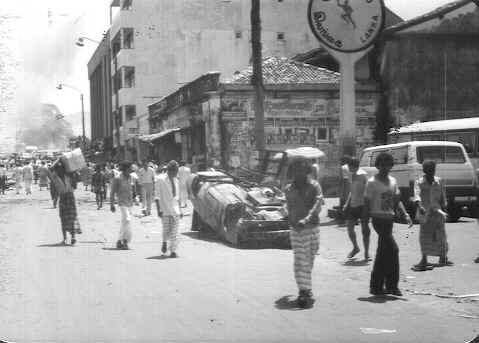
Buildings on Fire, Cars overturned and looters walking away with goodies, July 1983
I am quoting Rajan Hoole because it is in line with the information we on the News Desk gathered through our contacts that night. Piyadasa and reporters who went to Punchi Borella said they saw the JSS (Jathika Sevaka Sangamaya) gang in action. I was also a member of the JSS Lake House Branch at that time. Our driver, Ariyaratne, who was on duty that night, was a committee member of the JSS Lake House branch. He drove Piyadasa to Punchi Borella. He told me he saw some prominent JSS and UNP men leading the mob. He specifically mentioned the name of Sangadasa, Colombo Municipal Councillor and a close associate of Prime Minister Premadasa.By eleven in the night, Piyadasa and our reporters returned. They said Tamil houses on Kynsey Road, Barnes Place, Horton Place, Rosmead Place, Castle Street and places in the vicinity of the Cotta Road Railway station were under attack. Street lights had gone out and Tamil shops at the Borella junction had burst into flames. Heated tiles and asbestos sheets were cracking making sounds like gunfire. Unrestricted looting was on.
By midnight, we received reports that arson and looting had spread to Maradana, Dematagoda, Thimbrigasaya and Kirulapone.
I was worried about my sons. They were alone in the house. My wife was in Nigeria on a teaching assignment and my daughter was in Jaffna Medical Faculty. I rang home. My elder son told me there was no sign of any trouble in Dehiwala. I went to Lake House Transport Department around 1 am. Drivers advised me not to step out of Lake House. “They are killing and burning Tamils,” they said. I told them that my sons are alone at home. Ariyaratne agreed to drive me home. I saw no sign of any disturbance along Galle Road. Dehiwala was calm.
Around 5 a.m. I received a call from a Sinhala friend. He was a top UNPer. He warned, “Saba! Don’t send your children to school. Go to some safe place before 9 o’ clock.”
I asked him whether curfew was declared.
He said, “NO.”
“Why? Last night police told us that they had advised the President to declare the curfew,” I asked.
My friend curtly replied, “Don’t ask me anything. Do as I tell you.”
We were told by the police that they had strongly advised the president to impose a curfew. His reply was, “I will consider.” But curfew was not imposed.
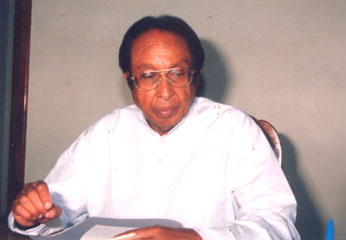
Ronnie de Mel 2002
We were also told by Finance Minister Ronnie de Mel that he had impressed upon President Jayewardene to declare curfew. De Mel said the president seemed agreeable.
Jayaratnam Wilson wrote later in the Lanka Guardian that he was in Colombo during that time. He rang Jayewardene around midnight. He urged him to declare curfew. Jayewardene did not speak to him about declaring a curfew. He advised Wilson not to get out. “Be in your home,” was his advice.
I followed my friend’s advice. We had our breakfast. I told my sons to bring a few clothes and their books. My eldest son was then studying for the GCE AL examination scheduled for August and my younger boy for the GCE OL December examination. I gave the keys to my neighbour’s daughter and told her that I would be back after the trouble was over. We went at about 8 am in a taxi to my nephew’s home at 6, Castle Lane, near the Bambalapitiya Manikka Vinayagar temple.
I saw St. Peter’s College functioning and was told that almost all the schools were working. Shops were open and traffic was normal. At 10 a.m. I sent my son to buy lunch parcels. He returned with them and with the news that the attack had commenced. He said shops were closing saying that an armed gang had started burning Tamil-owned shops along Galle Road. The attack had started from the Galle Face end of the Galle Road.
Around 10.30 a.m. Thurairatnam, a boarder in my nephew’s house, came back scared, exhausted. I have never seen him in that state before. Jovial by nature he took difficulties lightly. He said he was at Bambalapitya junction when the gang reached it. He witnessed the breaking and burning of shops. He also saw the mob hammering a few Tamils.
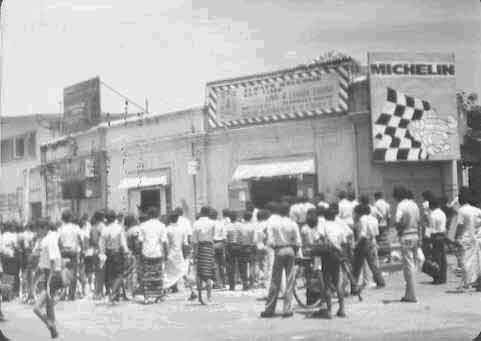
A Sinhala mob looting a Tamil shop, with uniformed policemen looking on, July 1983
He said he saw two study men jumping out of their truck and breaking open Tamil shops. He later described to me how professional those men were. They first looked at a list they carried with them, then looked at the name board to check whether they were going to the correct shop. Thurairatnam said one of the men carried an axe and the other a crowbar. The man with the axe broke the lock with a hard knock with the back of the axe. The man with the crowbar pulled the door open and signaled the mob that trailed him to loot the shop. They then moved on to the next shop. The ritual was repeated there, too. They wanted those shops to be looted; not to be burnt. The buildings in which those shops operated were owned by Sinhalese.
Thurairatnam did not wait. He saw the mob chasing a Tamil. He walked briskly and came home. In another five minutes, there was commotion on the Galle Road near our house. My sons peeped out and said the shops near the temple were on fire. Two Indian Tamil boys came running. They said they were standing opposite the temple when the trained gang reached there. They said they saw the two men who forced open the door signaling the men in the truck to burn the shops. They poured petrol into the shop and threw a lighted cloth. The shop burst into flames. That shop and the building belonged to a Tamil.
I telephoned Aaron at Daily News. “Are you safe?” he asked.
“Till now,” I replied.
He told me that the entire Colombo was burning. He said, unlike in 1977, this time Tamil houses were being attacked. He cautioned me to be vigilant.
Around noon, I realized Aaron was correct. A crowd started attacking the last house in my lane. The mob had come along the beach. A few more men sought refuge in our house. Dr. S. Arulambalam, elder brother of my cousin and a dental surgeon at the Jaffna Hospital who had come on official work to the Colombo Hospital, returned exhausted. He had walked all the way from Town Hall. He said he saw Tamils being killed and burnt on the road.
I saw the attacking mob advancing to the second and third houses at the end of the lane. I asked all in our house to jump over the parapet wall into the neighbour’s compound. The neighbour, a Muslim, asked them to get into their toilet. Dr. Arulambalam, a heavily built person, found it difficult to scale the 5- foot wall. Two young boys lifted and threw him to the other side. The men on the other side caught him.
I had no time to waste. I must save my sons and the others who were in the house. I telephoned Mahaweli Minister Gamini Dissanayake. His wife said he was out. “He had gone out to help one of his friends,” she said. I had no time to talk. I called Finance Minister Ronnie de Mel. I was told he was out for a meeting with President Jayewardene. Then I called Fisheries Minister Festus Perera. He was also with President Jayewardene. The person who took the call offered to give the message to Festus Perera. I gave my address and told him to inform the minister I needed some protection.
President Jayewardene was at the Presidential Secretariat from 8 a.m. Ronnie de Mel later told me he met him there around 11 a.m. and was with him till around 1 p.m.. He said he went to meet him after the mob attack on the Tamils and their property began at 10 a.m. Festus Perera also told me that he was with Jayewardene around that day.
Thondaman also met him around that time. As his biographer and as his media consultant, I was in close touch with Thondaman for nearly three decades. Thondaman told me that when he met him, Jayewardene was cool and collected. He was listening to the other ministers and officials who were relating to him the gory scenes they had witnessed.
“I was very, very agitated at that time. I had just then managed to bring my granddaughter to the safety of my house. On the way from my house to the Presidential Secretariat, I saw mobs attacking Tamils and burning their property. ‘You must stop this,’ I almost shouted in anger. The President answered. ‘What can I do?’ I told him to declare curfew. ‘Who is to enforce it?’ the President asked. I was at a loss to say anything. All I could say was that he should take action to bring the violence to a stop,” Thondaman told me.
Festus Perera acted on my request for protection. A police patrol visited the Castle Lane house in which I was and placed a police guard at the top of my road. That prevented the mob advancing towards my nephew’s house.
President Jayewardene, ministers and top men in the defence establishments took action to safeguard the people they wanted to protect. Jayewardene sent a jeep with an armed escort to bring Charmaine Vanderkoon, his daughter-in-law through her first marriage to his son, Ravi, and mother of his grand son, to the safety of his house. He feared that Charmaine, a Tamil, would be harmed by the mob.

Tamil, subsequently killed, being tormented by a mob, July 1983
Jayewardene also sent an army unit when he was told that Kumarasuriyar was being tormented by the Sinhala crowd. Eyewitness accounts said an unruly crowd had tied Kumarasuriyar with a rope and dragged him to the petrol shed close to his house and was tormenting him with insults. The army unit saved him when the mob was about to club him to death.
Gamini Dissanayake went to late S. J. V. Chelvanayakam’s house to save his son Chandrakasan and his mother. Chandrakasan was his friend from Law College days. Thondaman told me that Prime Minister Premadasa sent his thugs to save his grand-daughter whose house was surrounded by thugs.
Trade and Shipping Minister Lalith Athulathmudali, whom I met at a press conference at his ministry about 10 days after the riot, told me he could have saved my house if I had given him a ring. “I was in and out of Vandervert Place protecting my friends,” he said. At the time I rang the ministers, I knew that my house was burning. My concern at that time was to save my sons who were with me.
I was worried about my house. I expected it to be attacked and looted. I did not expect it to be burnt. I rang home around 11.30 a.m. The telephone was ringing. I rang again half an hour later. The telephone was silent. I rang my neighbour Somadasa. He said the house was burning. I could hear him sobbing.
“We tried to save the Tamil houses in our area, but failed,” he told me when I met his two weeks later. “A crowd came searching for Tamil houses. We told them that there were no Tamil houses in the area and sent them away. A little later, the crowd came back led by a policeman attached to the Dehiwala Police Station. He showed us the electoral list and scolded us for trying to protect the Tamils. He took the crowd to your house,” he said.
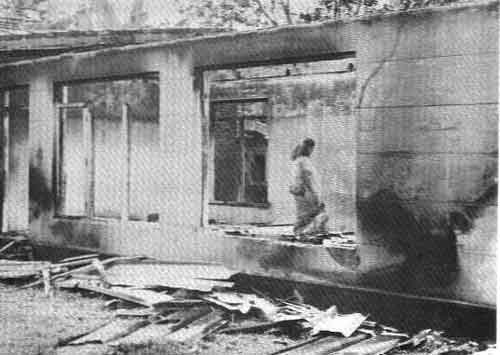
A burnt Tamil home, July 1983
My neighbours also told me that the police constable had told them that the Tamils should be driven out. After burning the three houses on our road, P. T. de Silva Mawatha, he announced to the crowd in Sinhalese, “Api suddha kara,” meaning they had done the cleansing there.
My house burnt for three days, neighbours said. A fisherman, Simon, who supplied us fish, told me that he was with the crowd that burnt my house. “They first broke open the door,” he said, “and entered the house. Two of then smashed the showcase in the sitting room. They pulled out the books and spread them over the hall set. They poured petrol on the books.”
Simon said the police constable then told the people to remove whatever they could. “Within 10 minutes the people looted everything,” he said. “Then they set fire.”
In the showcase I did not keep curios. I kept dictionaries, glossaries and encyclopedias. In 1957 when I joined Lake House, Sri Lanka was undergoing a major sociological and cultural revolution. The medium of instruction in schools and universities was changed from English to Sinhala and Tamil. That necessitated the preparation of glossaries in Sinhala and Tamil and the translation of standard textbooks from English to Sinhala and Tamil. Being a graduate proficient in English and Tamil I started translating university textbooks in economics and politics for the Publications Department of the Education Ministry. After marriage in 1961 my wife, a science graduate teacher, started translation and textbook writing. To help our work we stocked English, Tamil and English to Tamil dictionaries and glossaries.
Those hardcover volumes, the arsonists found, were handy for their work. They smoldered for two days scorching the entire building. They also went to my study, a separate room I had constructed outside the main house, where I stocked all my books, collections of documents, clippings and newspapers and repeated the ritual – bathing it with petrol and purifying with fire.
Highly Organized
Mine was one of the twenty-odd houses of the media personnel ‘purified’ that Monday morning. Three of those houses belonged to members of the Daily News. I was the Deputy Editor (News), K. Nadarajah the Features Editor and P. Balasingham Local Editor. The houses of R. Sivagurunathan, Editor Thinakaran, R. Sivapiragasam, Editor Virakesari, Ponmani Kulasingham, Director, Tamil Service, Sri Lanka Broadcasting Corporation were also torched. All these houses, situated at different parts of the Colombo city, were set alight about the same time, between 11.30 a.m. and 12.30 a.m.
Similar destruction was caused to the homes of other professionals – doctors, engineers, lawyers, accountants, businessmen. Tamils are convinced that the riots were organized to destroy the professional, business and the economic base of the Tamil community.
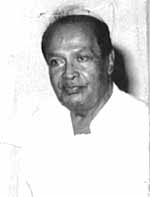
Montague Jayawickreme 2001
Tamils are also convinced that this destruction was organized by the ‘very top’ They reject completely the theory that the holocaust was the spontaneous outpouring of Sinhala fury, a reaction to the Thirunelveli ambush. Tamils believe the killing of 13 soldiers served only as a trigger, One of my friends was a neighbour of Montague Jayawickreme, Minister of Plantation Industries in the Jayewardene government. Jayawickreme spent the weekend in his estate and returned to his Colombo home on Monday noon. He went out to help his Tamil neighbours and told them, “Jayewardene has unleashed his hounds and now he cannot call them back.”
Jayewardene’s ministers and their men were seen that morning in various parts of Colombo directing their thugs. Industries Minister Cyril Mathew was seen in Colombo Fort, Prime Minister R, Premadasa’s trusted lieutenants, especially pavement hawkers, in Pettah, Colombo Mayor’s thugs and municipal labourers and UNP municipal council members Transport Minister M. H. Mohammed’s men in Borella, District Minister Mallimarachchi’s goons in Colombo north and Deputy Minister Anura Bastian’s strongmen in Colombo South.
While I telephoned for assistance, a youth from Mannar ran into our house in a frightened state and collapsed on the verandah. When revived he said he and his friend were returning from their office when a frenzied crowd started chasing them. “We ran but the crowd caught of my friend. I hid myself behind a building and watched. They clubbed him to death. Then they brought an old tyre, put his body over it, poured petrol and set fire to it,” he said. He could not get over that harrowing experience. Later I heard he had joined the LTTE.
The experience of another friend, Kumarasamy, who came to our house on Tuesday, was somewhat different. He was in his room at Ratnakara Place in Dehiwala when the mob surrounded his house. Some youths caught him, dragged him to the road and asked him to sit down. Some assaulted him, which others prevented. There was a dispute among them as to what they should do to him. A few suggested that they should burn him to death. Two youths then walked away to the petrol station to fetch petrol. Others stood guard around him.
One youth bent down and whispered into his ear, “You fool. Why are you sitting like this? Get up and run.”
My friend obeyed. He got up and ran. He ran to a policeman who was standing on the top of the road. The police constable sent him to the refugee camp and he came to our house the next day.
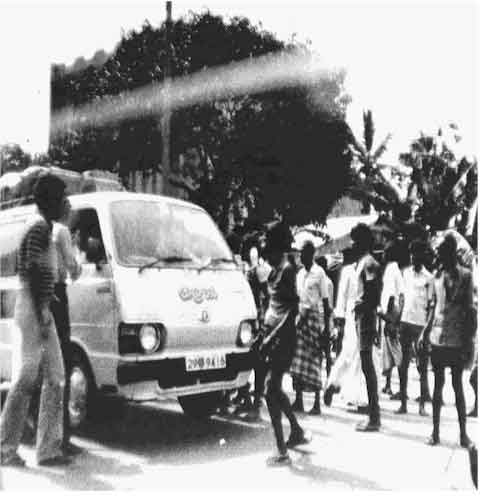
Sinhalese mob stopping cars looking for Tamils, July 1983
I am recounting these selected incidents to disprove the theory of collective Sinhala fury advanced by Jayewardene and his followers. There were numerous instances where good-natured Sinhala people helped to save the Tamils even at the risk of their lives. They were threatened. They were told that they would be killed and burnt along with the Tamils whom they were protecting.
A top government official, Bradman Weerakoon, who served as secretary to six prime ministers, and a trusted advisor to Jayewardene, who sheltered his neighbours in his home received threatening telephone calls. He told me he took the neighbours to the refugee camp. “Not that I was scared,” he said. “But I had to safeguard the lives of those whom I sheltered. I did not want to take any risk.”
My conclusion, after living through it and seeing it from close hand, is that it was an engineered event.
 L. Piyadasa in his book Sri Lanka The Holocaust and After provides evidence to show that the Government had made preparations to attack the Tamils long before the Thirunelveli ambush. The book supports the evidence I had collected about the use of electoral lists to identify the shops and houses of Tamils. A Tamil officer who worked at the time of the riots at the office of the Registrar of Companies told me that a copy of the list of companies was obtained from his office.
L. Piyadasa in his book Sri Lanka The Holocaust and After provides evidence to show that the Government had made preparations to attack the Tamils long before the Thirunelveli ambush. The book supports the evidence I had collected about the use of electoral lists to identify the shops and houses of Tamils. A Tamil officer who worked at the time of the riots at the office of the Registrar of Companies told me that a copy of the list of companies was obtained from his office.
Proof for the suspicion of top-level connivance comes from the very behaviour of Jayewardene on Sunday night and on Monday. On Sunday night, though officials and advisors were disturbed about the unfolding events at Borella and Maradana, Jayewardene was calm and unruffled according to DIG Edward Gunawardene.
This is the impression Edward Gunawardene records in his book Blood & Cyanide about Jayewardene, whom he met him around Sunday midnight. He said:
The President was keeping up with his family. Dressed in an elegant maroon dressing gown he was seated in an armchair listening to the various officials who dropped on and off. He was calm and unruffled in the face of all the reports coming in from different parts of the country. Rumour of army involvement and vacillation on the part of some units were certainly giving him concern.
Jayewardene was aware of the events happening outside. But his main worry was whether some units of the army might revolt. But he had kept the army commander Tissa Weeratunga in Jaffna the whole day. He returned to Colombo with the bodies of the 13 soldiers after 8 on Sunday night.
Police and some senior advisors had repeatedly advised Jayawardene on Sunday night and on Monday morning to declare curfew. He did not do so.
Why?
Most of the Tamils, including Pirapaharan, see the government as an active agent in these atrocities.
Next: Chapter 4 Prison Riots